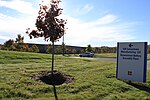| North Tarrytown Assembly | |
|---|---|
 Remnants of the former GM plant in 2014 | |
|
| |
| Operated | 1896 - 1996 |
| Coordinates | 41°5′3″N 73°52′11″W / 41.08417°N 73.86972°W |
| Industry | Automotive |
| Products | Automobiles |
| Owner(s) | General Motors |

The North Tarrytown Assembly was an automobile factory in North Tarrytown, New York, United States, now known as Sleepy Hollow, situated on the Hudson River. The 90-acre (36 ha) plant was in operation from 1896 to 1996. Originally opened by the Stanley Steam Car Company, the plant was acquired by Maxwell-Briscoe in 1903 from the Ingersoll-Rand Drill Company. In 1913 Maxwell-Briscoe was renamed Maxwell Automobile Company. Separate portions of the complex were acquired by Chevrolet in 1914 and 1915. At this time Chevrolet was an independent company and not yet part of General Motors. In 1918 Chevrolet was integrated into General Motors.
A range of General Motors products were assembled in Tarrytown over the years; most were Chevrolet products, starting with the Chevrolet Series 490. Tarrytown also produced the 50 millionth Chevrolet, a special gold-colored 1963 Impala SS with the 409 cubic-inch V8. [1] [2] Its last vehicles produced were GM's second generation minivans. These were the Chevrolet Lumina APV, Pontiac TranSport, and Oldsmobile Silhouette, but sluggish sales spelled the end for GM's Tarrytown operations with its 2100 employees. [3] It was closed at the end of June 1996 when production of minivans was moved to Doraville Assembly in Georgia. [4] Metro-North Railroad's Hudson Line runs through the property, and some of the siding tracks that used to serve the factory have been taken over by Metro-North as overflow storage tracks for maintenance of way equipment.
The plant was a noted polluter of the Hudson River. The plant used about 1 million gallons of water per day, which was returned to the river as waste. The plant's industrial waste (primarily lead chromate and other painting, cleaning, and soldering chemicals) would be emptied directly into the river. Domestic waste would be processed through the village's sewage treatment plant. Around 1971, the village's Sewer and Water Superintendent assured that the pollution reports were exaggerated, and that he and other residents would swim by a beach nearby, however Dominick Pirone, an ecologist and former director of the Hudson River Fishermen's Association (now Riverkeeper) was quoted as saying: "You can tell what color cars they are painting on a given day by what color the river is." [5]
The site today is now being developed, with the parcel west of the railroad becoming a mainly-residential Toll Brothers development named "Edge-on-Hudson" and the east parcel retained by the Village of Sleepy Hollow for a new Department of Public Works garage and other facilities for the public.
Models
Some of the models produced at the plant included:
- 1915-1922 Chevrolet Series 490
- 1923-1926 Chevrolet Superior (introduction of GM "A" platform)
- 1927 Chevrolet Series AA Capitol
- 1928 Chevrolet Series AB National
- 1929 Chevrolet Series AC International
- 1930 Chevrolet Series AD Universal
- 1931 Chevrolet Series AE Independence
- 1932 Chevrolet Series BA Confederate
- 1933 Chevrolet Eagle
- 1933 Chevrolet Standard Six
- 1933-1942 Chevrolet Series CA Eagle / Master
- 1935-1966 Chevrolet Suburban
- 1941-1947 Chevrolet AK Series
- 1941-1952 Chevrolet Deluxe/ Chevrolet Fleetline
- 1947-1955 Chevrolet Advance Design
- 1950-1975 Chevrolet Bel Air
- 1953-1957 Chevrolet 150/ Chevrolet 210/ Chevrolet Townsman
- 1954-1958 Chevrolet Delray
- 1955-1957 Chevrolet Nomad
- 1955-1959 Chevrolet Task Force
- 1958-1970 Chevrolet Biscayne
- 1958-1976 Chevrolet Impala
- 1960-1966 Chevrolet C/K (first generation)
- 1966-1976 Chevrolet Caprice
- 1967-1972 Chevrolet C/K (Action Line)
- 1967-1972 GMC C/K (Action Line)
- 1975 Buick Apollo
- 1975-1979 Buick Skylark
- 1975-1979 Chevrolet Nova
- 1975-1977 Pontiac Ventura
- 1977-1979 Pontiac Phoenix
- 1980-1983 Buick Skylark
- 1980-1985 Chevrolet Citation
- 1980-1984 Pontiac Phoenix
- 1990-1996 Chevrolet Lumina APV/ Chevrolet Lumina Minivan
- 1990-1996 Pontiac Trans Sport
- 1990-1996 Oldsmobile Silhouette
See also
References
- ^ "Nelson Rockefeller in 50 millionth Chevrolet automobile on assembly line". 10 June 1963.
- ^ Bogdan Popa (13 September 2022). "This 1963 Chevrolet Impala Likely Parked Since Forever Hopes Nobody Looks Inside".
- ^ Lueck, Thomas J (1996-06-27). "Auto Plant Closes And Developers See Opportunity; North Tarrytown Focuses On Its Future Instead of the Past". New York Times: B1.
- ^ Lueck, p. B6
- ^ Greenhouse, Linda (January 12, 1971). "Pollution Accusations Against G.M. Dismay North Tarrytown". The New York Times. Retrieved September 26, 2017.
